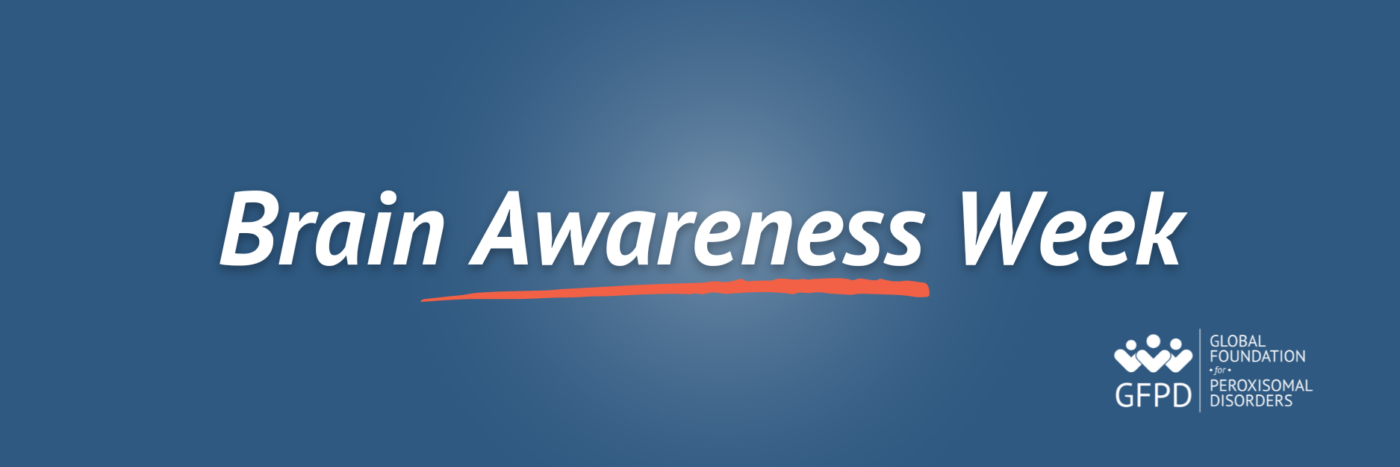
Brain Awareness Week is a global campaign during the week of March 13-19, 2023. There are several reasons why individuals with peroxisomal disorders periodically undergo many tests to monitor the health and potential changes in their brain.
One example would be the ability to know where seizures begin in the brain to help provide information about the type of seizure and how to help treat them. A doctor may order an electroencephalogram (EEG) to examine the brainwave patterns, or you may have a video EEG (VEEG). A VEEG will continuously record what you are doing while simultaneously examining the brainwave patterns. The VEEG can help determine what activities are or are not seizures, what type of seizures are occurring, and know what area of the brain the seizures are beginning.
VEEG testing is usually completed in the hospital and can take place over several days. It is considered a safe, non-invasive test; however, individuals with peroxisomal disorders often have increased sensitivity to varying sensory input. This is often due to their combined vision and hearing loss. During the VEEG electrodes are temporarily glued to the patient’s head, and with sensory sensitivities, could be quite stressful for the patient and their caregiver.
Individuals with peroxisomal disorders may have different types of seizures throughout their life. For example, GFPD Warrior, TJ had his first seizure at age 8 months old. An EEG helped determine the type of seizures and how they were beginning in one area of the brain. As he got older, the appearance of his seizures changed and the ability to control them changed too. VEEG testing has been used periodically throughout his life to monitor how his seizures physically manifest, but also have helped determine what behaviors and movements are not seizures. Currently, TJ’s seizures occur from all areas of the brain, and are controlled with two different medications taken multiple times a day.
Brain imaging may also be used for many reasons when an individual has a neurological condition. Brain imaging, such as magnetic resonance imaging (MRI) may be ordered to monitor the structure of the brain and how it looks.
Below are a few facts about MRI’s, EEG’s and seizures according to a 2020 article about symptom prevalence in this disease, which is the largest one to date on patients with PBD-ZSD.
- 47% (n = 15, out of 32 who indicated their child had an EEG) reported that their child’s EEG was abnormal, while 89% of caregivers of deceased individuals (n = 17, out of 19 who indicated their child had an EEG) reported that their child’s EEG was abnormal (p = 0.007, Table 1).
- Regarding MRIs, 57% of family caregivers for living individuals with ZSD (n = 25, out of 32 who indicated their child had an MRI) reported that their child’s MRI was abnormal, and 89% of caregivers of deceased individuals with ZSD (n = 16, out of 18 who indicated their child had an MRI) reported that their child’s MRI was abnormal (p = 0.044, Table 1).
- The combined reported prevalence of seizures in all individuals with ZSD was 53%.
- Seizures occurred in 72% of the participants with deceased children, and 44% of participants with living children.
- Considering the larger sample size, our findings may be closer to indicating the real prevalence of seizures in the ZSD population. Actually, seizure prevalence may be even higher than 44%, because not all participants reported that their child ever had an EEG, thus raising the possibility that seizures may have been overlooked by caregiver observation.
To learn more:
- About the brain and epilepsy, visit the Epilepsy Foundation.
- About neurological conditions, visit the Child Neurology Foundation.
- About peroxisomal disorders, visit www.thegfpd.org
- About the cross-sectional symptom prevalence survey Zellweger spectrum disorder: A cross-sectional study of symptom prevalence using input from family caregivers
Written By Katie Sacra
